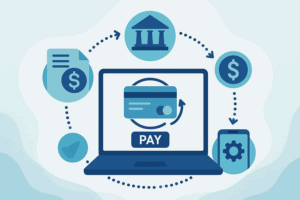
Gone are the days when companies had to install programs on every computer and manage all the updates and issues themselves. Today, more organizations are turning to cloud-based software, also known as Software as a Service (SaaS), with products by Microsoft, Salesforce, Oracle, SAP, and Google leading the market.
In this article, we’ll break down what SaaS really is and why it’s growing in popularity. Find out what challenges you might face during the switch and how to make the transition smoother with multi tenant architecture in SaaS solutions.
What Is SaaS and Why Do Businesses Use It?
SaaS is a model where software runs on the internet instead of being installed on individual computers. Businesses pay a regular fee (monthly, quarterly, or yearly) to access the service, and the provider takes care of everything: hosting, maintenance, updates, and security.
With SaaS, you always have the latest version, you can use it from anywhere, and you don’t have to worry about technical setups. Still, it’s not the only advantage of cloud-based software.
Predictable Costs and Steady Revenue
SaaS uses a subscription model, implying users are billed monthly or annually instead of a one-time purchase. For businesses using the software, this offers financial predictability. For those providing the software, it creates a stable stream of recurring revenue that makes growth more sustainable.
Always Up to Date
Traditional software often becomes outdated quickly, requiring manual upgrades or full reinstallations. With SaaS, updates are automatic and rolled out by the provider. This means users always have access to the latest features, performance improvements, and security patches effortlessly.
Lower Operational Costs
Maintaining in-house software infrastructure can be costly. Businesses need servers, IT staff, and time to manage installations, updates, and security. SaaS eliminates many of these responsibilities. The service provider handles all the technical work, which significantly reduces overhead.
Flexibility and Scalability
Whether you’re a startup or a growing enterprise, SaaS can adapt to your needs. You can scale up (or down) depending on your usage.

Need more storage or users? Just upgrade your plan. You’re not locked into rigid hardware limitations because the system grows with you.
Easy Access Anytime, Anywhere
Since SaaS lives in the cloud, users can access it from anywhere. All you need is an internet connection. This makes remote work and collaboration easier, as teams can stay connected and work on the same platform regardless of location.
Faster Deployment
Launching a traditional software solution can take weeks or months. SaaS tools are often ready to use almost immediately. Businesses can test ideas faster, launch services quickly, and respond to market changes without delay.
Enhanced Security (with Shared Responsibility)
SaaS providers invest heavily in security, often more than individual companies can afford to do in-house. Data encryption, backups, and disaster recovery plans are typically built in. While businesses still need to protect their own access and sensitive data, the foundational security is already strong.
What Makes the Transition Challenging & How to Handle It
Switching to SaaS has great potential, but it also comes with some hurdles.

Here’s what to look out for:
- Reworking your app’s design. Many traditional programs need to be reorganized to work properly in the cloud. This may mean splitting up large systems into smaller, more flexible parts.
- Choosing the right approach. You can migrate all at once, in layers, or simply move the data first. The best path depends on how your software operates and how quickly you want to launch.
- Budgeting accurately. Cloud costs are ongoing and depend on usage, so they can be harder to predict than single purchases. You’ll need to monitor data storage, traffic, and users to stay on budget.
- Security responsibilities. SaaS providers offer strong protection, but ensuring your app and customer data are safe is still your job. That means checking for compliance with regulations and putting extra security controls in place.
To make your move to SaaS more successful, consider these tips:
- Look beyond just setup costs. Factor in user volume, server capacity, and long-term growth.
- Make sure your provider guarantees reliability, support, and clear terms for performance and downtime.
- Managing fewer partners can reduce confusion, lower expenses, and improve system integration.
- Define who’s responsible for what, including data access, updates, and compliance, so nothing gets missed.
- Let your customers choose from multiple tiers or pay based on usage. It increases appeal and helps you grow your customer base.
Conclusion
Moving to SaaS might seem like a huge step. Nevertheless, it’s quickly becoming the new normal for businesses that want to be agile, scalable, and future-ready. With the right plan, the transition can open up new revenue opportunities, improve customer experience, and amp up operations without the burden of managing software in-house.
No matter the company size, taking your software to the cloud is a smart business move that will work for your future growth.















